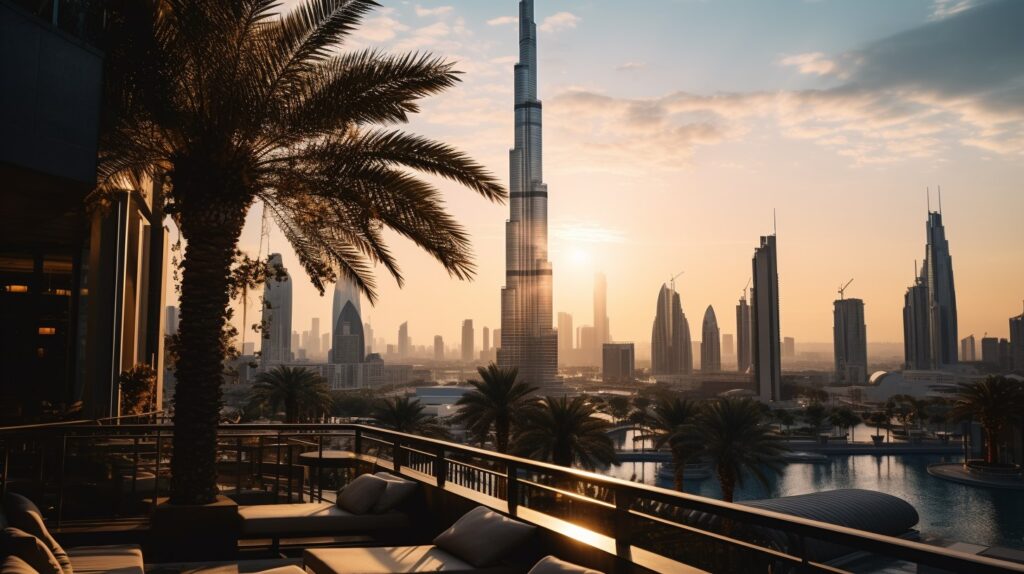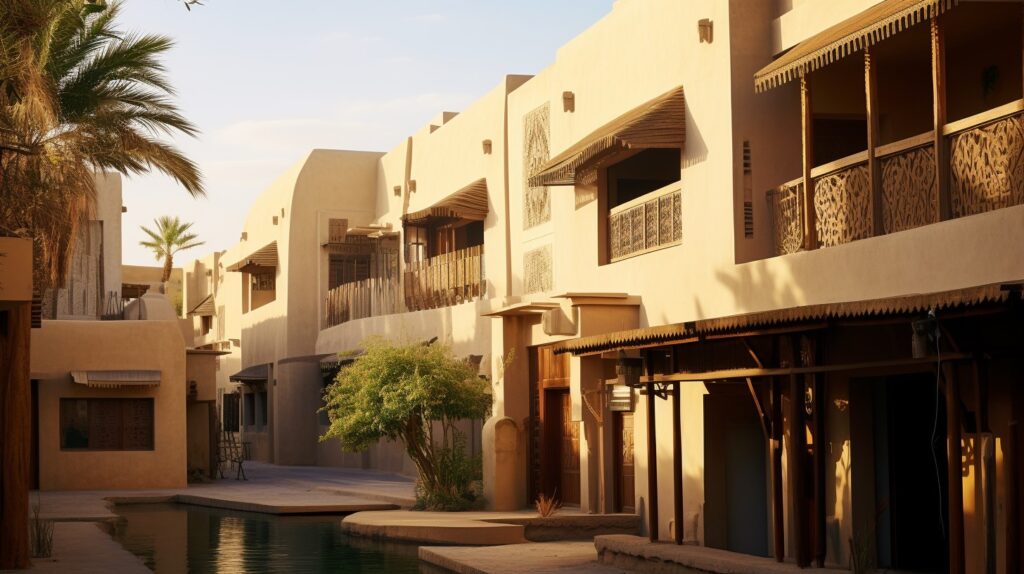Introduction
In the heart of the Arabian Peninsula, Dubai stands as a testament to architectural ingenuity, where the rich tapestry of its cultural heritage seamlessly blends with the boldness of modern design. This city, a melting pot of ancient traditions and futuristic aspirations, has carved out a unique architectural identity. From the wind towers of old to the soaring heights of the Burj Khalifa, Dubai’s skyline is a narrative of a city that has embraced its past while boldly stepping into the future. This article takes you on a journey through the architectural evolution of Dubai, exploring how the city has woven its rich cultural heritage into the fabric of its modern architecture.
Historical Foundations of Dubai’s Architecture
The architectural story of Dubai began long before the city became synonymous with luxury and innovation.
Traditional Bedouin and Islamic Influences: The roots of Dubai’s architecture lie in the simple yet functional structures of the Bedouin tribes and the ornate designs of Islamic architecture. The early buildings, made from palm fronds and mud bricks, were designed to withstand the harsh desert climate. The influence of Islamic architecture was evident in the mosques and forts, with their intricate arabesque patterns, minarets, and domes.
Early Architectural Styles and Materials: Traditional homes, known as Barasti, were built to provide shelter from the heat, with wind towers (Barajeel) for natural cooling. The Al Fahidi Historical Neighbourhood, formerly Bastakiya, is a living testament to these early architectural styles, showcasing the ingenuity of the first settlers in adapting to their environment.
Transition to Modernity
The discovery of oil in the 20th century marked a turning point in Dubai’s architectural journey, paving the way for a transition to modernity.
The Impact of Oil Discovery on Urban Development: The oil boom of the 1960s and 1970s brought wealth and a wave of modernization to Dubai. This period saw the introduction of contemporary building techniques and materials, leading to the construction of modern infrastructure and buildings.
Early Modern Architectural Projects in Dubai: The development of the Dubai Creek area and the Dubai World Trade Centre, one of the city’s first skyscrapers, marked the beginning of modern architecture in Dubai. These projects departed from traditional designs, incorporating elements of international architectural styles.
Incorporating Cultural Elements in Contemporary Design
As Dubai’s skyline reached for the stars, the city’s architects and developers sought to infuse modern structures with traditional and Islamic art elements.
Examples of Traditional Motifs in Modern Structures: Many of Dubai’s modern buildings incorporate traditional design elements, such as geometric patterns and arabesque designs. The Madinat Jumeirah complex, for instance, is a contemporary interpretation of a traditional Arab village, complete with wind towers and waterways.
The Role of Islamic Art and Calligraphy in Contemporary Architecture: Islamic art and calligraphy have found a place in modern Dubai’s architecture. With its dhow-shaped design, the Dubai Opera is an example of how traditional forms inspire modern structures. Islamic calligraphy in buildings like the Jumeirah Mosque and the Dubai International Financial Centre adds a cultural depth to their contemporary designs.
Iconic Modern Structures with Cultural Significance
Dubai’s skyline is a showcase of modern architecture and a canvas where the city’s cultural heritage is etched in stone and glass.
Burj Khalifa and its Design Inspirations: The Burj Khalifa, standing as the world’s tallest building, is a marvel that blends cutting-edge engineering with cultural motifs. Its design is inspired by the spider lily, a regional desert flower, and incorporates patterns from traditional Islamic architecture. The Y-shaped floor plan maximizes views of the Arabian Gulf, while the stepped design is a nod to conventional ziggurats, reflecting the region’s historical architectural practices.

Other Significant Buildings Blending Heritage and Modernity: Apart from the Burj Khalifa, several other structures in Dubai beautifully integrate cultural elements into modern designs. The Dubai Mall, for instance, features traditional Arabic lanterns and motifs alongside its contemporary structure. The Mall of the Emirates, with its traditional Arabic domes and arches, offers a glimpse of the region’s architectural history amidst a modern shopping experience.
Sustainable Architecture and Cultural Identity
In recent years, Dubai has embraced sustainable architecture, ensuring its rapid development does not come at the cost of environmental degradation or loss of cultural identity.
Green Building Practices in Modern Designs: Dubai’s commitment to sustainability is evident in its green building practices. Developments like the Sustainable City are designed to be environmentally friendly, focusing on renewable energy, water conservation, and waste reduction. These practices are seamlessly integrated into the city’s architecture, ensuring that the buildings are sustainable and aesthetically pleasing.
Maintaining Cultural Identity in Sustainable Architecture: Even in its pursuit of sustainability, Dubai has retained its cultural roots. Many sustainable buildings incorporate elements of traditional architecture, such as wind towers for natural cooling, reflecting the city’s commitment to preserving its cultural identity while embracing modernity.
The Role of Government and Urban Planning
The government of Dubai has played a pivotal role in shaping the city’s architectural landscape, ensuring that development aligns with its cultural heritage and modern aspirations.
Government Initiatives in Preserving Cultural Heritage: The Dubai government has implemented several initiatives to preserve the city’s cultural heritage. For instance, the Dubai Historical District project aims to revitalize the Al Fahidi Historical Neighbourhood, maintaining its traditional architecture while promoting it as a cultural and tourist destination.

Urban Planning Strategies Integrating Tradition and Modernity: Dubai’s urban planning strategies reflect a balanced approach to development. The city’s master plans focus on creating culturally relevant and sustainable spaces. The development of areas like Downtown Dubai and the Dubai Marina is a testament to the city’s ability to develop modern urban spaces rooted in the cultural ethos of the region.
Challenges and Critiques
As Dubai grows, it faces challenges in balancing modernization with cultural preservation, leading to critiques from various quarters.
Balancing Modernization with Cultural Preservation: One of the critical challenges facing Dubai is maintaining its cultural identity amidst rapid modernization. Critics argue that the city risks losing its architectural heritage in the race to build taller, more luxurious structures. There is a growing call for more developments that reflect the city’s history and traditions.
Critiques of Modern Architecture in the Context of Cultural Heritage: Some critics have voiced concerns over the sustainability and cultural relevance of some of Dubai’s modern architectural projects. They argue that while these structures are impressive, they need to reflect the local culture and environment more.
